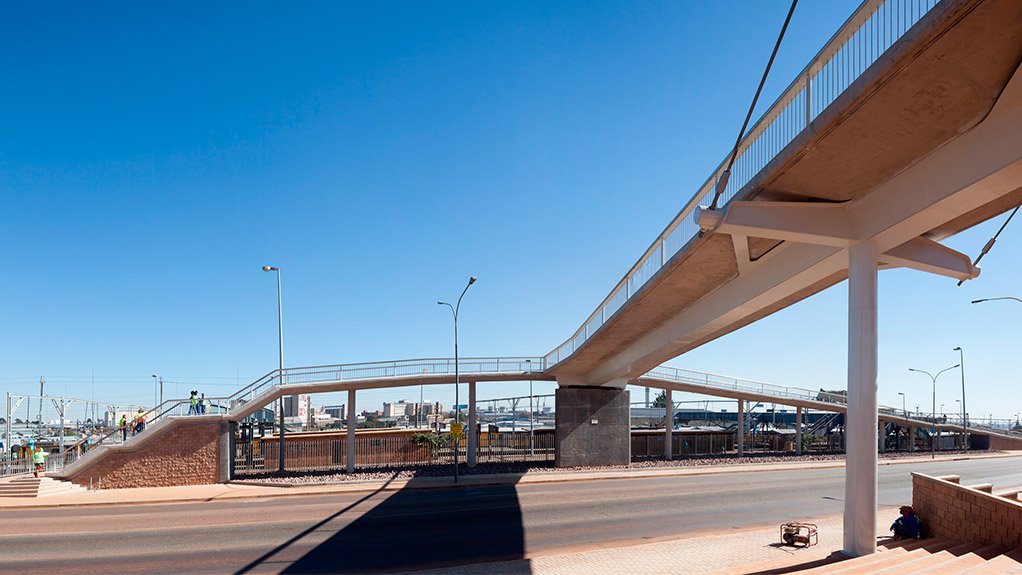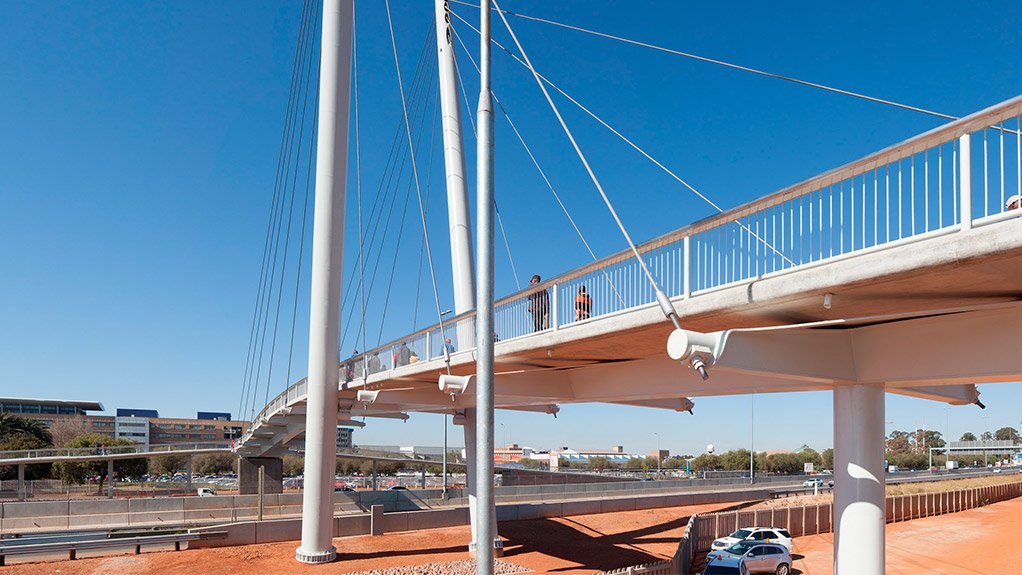Design competition encourages innovation



UPGRADE PROJECT The new bridge formed part of a broader project to upgrade the R21 highway
WALKING WONDER The bridge uses leaning, cigar-shaped towers to support cable-stays and the main span of the bridge
A concept design competition, which was launched in 2011, encouraging the generation of construction-design concepts for an aesthetically pleasing pedestrian bridge in Ekurhuleni, motivated professional services firm SMEC South Africa to employ innovative solutions for the three designs it entered in the competition, for which it was subsequently awarded a R47-million construction contract.
SMEC submitted three concept ideas for the bridge in 2011, with three other architectural practices also submitting three design concepts each. National roads network parastatal South Africa National Roads Agency Limited (Sanral) reviewed the nine design concepts for the new bridge.
Construction started in June 2012 and was finalised within budget in December 2013.
The new bridge formed part of a broader project to upgrade the R21 highway, which necessitated the replacement of two existing, but ageing, pedestrian bridges in the Isando area.
The two existing bridges were deemed inadequate to handle the growing pedestrian traffic expected from the Isando railway station. SMEC technical director Barry Schlebusch says that, while the one bridge was seldom used because of its inconvenient location, the other bridge was overused. “Both bridges also required substantial and increasing maintenance at the time and had to be demolished,” he adds.
Currently, about 9 000 to 10 000 pedestrians a day use the new bridge. “The bridge has been designed for a 7% growth rate in use over the next few years,” adds Schlebusch.
The bridge has been designed to, if need be, accommodate double its current capacity, with growth rates of pedestrian traffic expected to increase after the completion of an extension to OR Tambo International Airport. “The airport is planning a midfield terminal, and, with this terminal, we expect pedestrian traffic on the bridge to double from its current volume,” he says.
Challenges
Schlebusch says cost was one of the project’s biggest challenges, owing to the size of bridge. “We had to employ a few cost-cutting strategies to meet the client’s specified budget after our design was chosen.”
He adds that SMEC had to take into account the high volume of pedestrians and the considerably long span of the bridge.
Another challenge arose when Sanral specified that the bridge had to be “aesthetically pleasing” in its design, says Schlebusch.
The project overran its schedule by about six months, owing to the discovery of unexpected underground services, which included electricity cables that feed OR Tambo International Airport.
“As soon as construction started, we discovered a major services line in the exact area where we planned to build the main pylons of the bridge,” he says, adding that there were 36 high-voltage cables that had to be taken into consideration.
SMEC had to adapt its design to accommodate the electrical services, with the company having been allowed to reroute only half of the cables, with the rest having to be accommodated within the structure of the bridge pylons. An external contractor was used to reroute the cables.
Unique Form
The bridge is unique in terms of its form, says Schlebusch. “It is called the ‘Walking Wonder’ and uses leaning, cigar-shaped towers to support cable stays and the main span of the bridge.”
The cable stays are lock-coiled cables, which were imported from Italy. “These types of cables have never before been used in South Africa for cable-stay bridges,” he says.
Further, the cable-stay anchors are hidden within the structure, giving the appearance of uniformity.
The bridge has been designed to have a 100-year life span.
“I feel this bridge will set a benchmark in terms of future designs for aesthetically pleasing bridges,” he says, adding that Sanral “seems keen” to build bridges like this, with unique designs that add a unique aesthetic to an area.
Comments
Press Office
Announcements
What's On
Subscribe to improve your user experience...
Option 1 (equivalent of R125 a month):
Receive a weekly copy of Creamer Media's Engineering News & Mining Weekly magazine
(print copy for those in South Africa and e-magazine for those outside of South Africa)
Receive daily email newsletters
Access to full search results
Access archive of magazine back copies
Access to Projects in Progress
Access to ONE Research Report of your choice in PDF format
Option 2 (equivalent of R375 a month):
All benefits from Option 1
PLUS
Access to Creamer Media's Research Channel Africa for ALL Research Reports, in PDF format, on various industrial and mining sectors
including Electricity; Water; Energy Transition; Hydrogen; Roads, Rail and Ports; Coal; Gold; Platinum; Battery Metals; etc.
Already a subscriber?
Forgotten your password?
Receive weekly copy of Creamer Media's Engineering News & Mining Weekly magazine (print copy for those in South Africa and e-magazine for those outside of South Africa)
➕
Recieve daily email newsletters
➕
Access to full search results
➕
Access archive of magazine back copies
➕
Access to Projects in Progress
➕
Access to ONE Research Report of your choice in PDF format
RESEARCH CHANNEL AFRICA
R4500 (equivalent of R375 a month)
SUBSCRIBEAll benefits from Option 1
➕
Access to Creamer Media's Research Channel Africa for ALL Research Reports on various industrial and mining sectors, in PDF format, including on:
Electricity
➕
Water
➕
Energy Transition
➕
Hydrogen
➕
Roads, Rail and Ports
➕
Coal
➕
Gold
➕
Platinum
➕
Battery Metals
➕
etc.
Receive all benefits from Option 1 or Option 2 delivered to numerous people at your company
➕
Multiple User names and Passwords for simultaneous log-ins
➕
Intranet integration access to all in your organisation




















